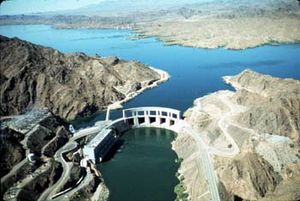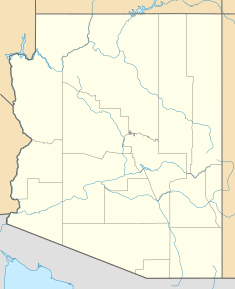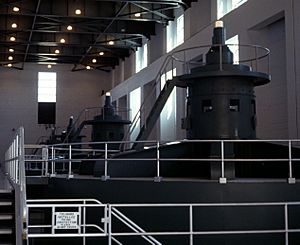Parker Dam facts for kids
Quick facts for kids Parker Dam |
|
|---|---|
 |
|
|
Location of Parker Dam in Arizona
|
|
| Location | San Bernardino County, California La Paz County, Arizona |
| Coordinates | 34°17′47″N 114°08′23″W / 34.29639°N 114.13972°W |
| Status | In use |
| Construction began | 1934 |
| Opening date | 1938 |
| Owner(s) | United States Bureau of Reclamation |
| Operator(s) | United States Bureau of Reclamation |
| Dam and spillways | |
| Type of dam | Concrete gravity-arch |
| Impounds | Colorado River |
| Height | 85 ft (26 m) |
| Height (foundation) | 320 ft (98 m) |
| Length | 856 ft (261 m) |
| Width (crest) | 39 ft (12 m) |
| Width (base) | 100 ft (30 m) |
| Spillway type | Service, controlled |
| Spillway capacity | 400,000 cu ft/s (11,000 m3/s) |
| Reservoir | |
| Creates | Lake Havasu |
| Total capacity | 646,200 acre⋅ft (797,100,000 m3) |
| Catchment area | 178,392 sq mi (462,030 km2) |
| Surface area | 19,300 acres (7,800 ha) |
| Power station | |
| Turbines | 4 x 30 MW Francis turbine |
| Installed capacity | 120 MW |
| Annual generation | 456.944 GWh |
Parker Dam is a concrete arch-gravity dam that crosses the Colorado River 155 miles (249 km) downstream of Hoover Dam. Built between 1934 and 1938 by the Bureau of Reclamation, it is 320 feet (98 m) high, 235 feet (72 m) of which are below the riverbed (the deep excavation was necessary in order to reach the bedrock on which the foundation of the dam was built), making it the deepest dam in the world. The portion of the dam above the foundation stands 85 feet (25.9 m) tall, making it the only dam in the world that stands more underground than above ground. The dam's primary functions are to create a reservoir, and to generate hydroelectric power. The reservoir behind the dam is called Lake Havasu and can store 647,000 acre⋅ft (798,000,000 m3; 2.11×1011 US gal; 1.76×1011 imp gal). The dam straddles the Arizona-California state border at the narrows the river passes through between the Whipple Mountains in San Bernardino County, California and the Buckskin Mountains in La Paz County, Arizona.
Power generation
The power plant has four Francis turbines with a combined capacity of 120 MW. Each turbine weighs 60,000 pounds (27,000 kg). The head is 72 feet (21.9 m). It produces electricity at 97 percent efficiency. Half of the electricity the plant produces is used by the Metropolitan Water District to pump water along the Colorado River Aqueduct, and the rest is sold to utilities in California, Arizona and Nevada. The generation of power is limited by a requirement to keep the water level of Lake Havasu between 440 and 450 feet (134.1 and 137.2 meters) above sea level for proper operation of pumping plants for the Central Arizona Project and the Colorado River Aqueduct.
Water supply
Lake Havasu is the water source for the Colorado River Aqueduct. The aqueduct is operated by the Metropolitan Water District of Southern California, which supplies water to almost all cities in the greater Los Angeles, San Bernardino, and San Diego areas. The district paid for nearly the entire cost of the dam, but it is owned and operated by the U.S. Bureau of Reclamation.
Lake Havasu is also the water source for the Central Arizona Project Aqueduct (CAP). The project is designed to provide water for irrigated agricultural areas, as well as municipal water for several Arizona communities, including the metropolitan areas of Phoenix and Tucson.
Gallery









